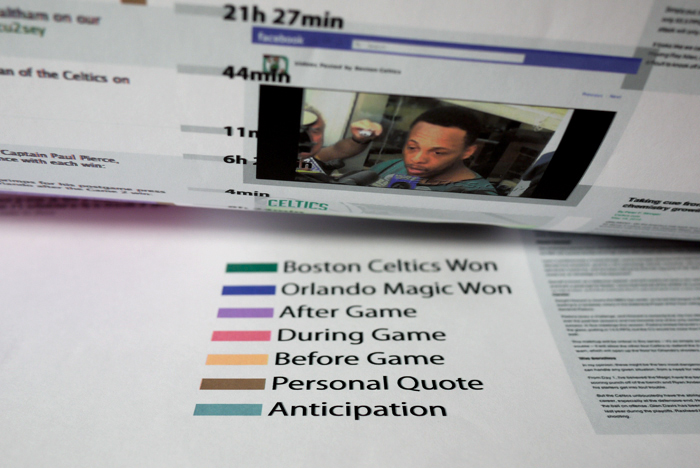



This visualization presents parallel responses a posted on Twitter during NBA 2009-2010 Eastern Conference Final from two organizations above. There were two main discoveries from the analysis of twitter feeds. The first discovery was the difference in voice from each organizations. The Twitter feeds from the Boston Globe usually featured a link to their articles, which are discuss predictions before the game as well as a post-game analyses. The articles posted by Boston Globe journalists were very insightful, precise and helpful in understanding the game. Its in-depth analysis, however, didn't excite or create hype for the anticipation of what could happen in the games. On the other hand, the Twitter feeds from Boston Celtics Official account didn't carry in-depth analyses and predictions but it featured inside data such as, pictures from the locker rooms and from players outside the court. It also tweeted quotes from the coach and players. Information that viewers received through the Boston Celtics Official Twitter account seemed more authentic and authorized. Quotes from Doc Rivers such as, "Sheed had spasms and tightness in his back but will play tonight." May 28, 2010 4:41PM had a more powerful voice and influential to the fans and created more excitement than Boston Globe's polished article. It was one line of less than 144 characters that delivered more excitement than a paragraph of words.
The second discovery was the influence of the media on its fans and the game itself. In sports games, there is alway a key point in each game that the media will inform the audience about, which is treated as a "must-know" fact. For instance, if there is news about one team's changing offense strategy for the next game, the media will focus on that fact and broadcast more footage to make the game more interesting. Due to this, extensive media coverage on a certain key aspect, the attention can miss other key attributes of the game. It seemed like watching a live event with a scripted scenario which is similar in structure to that of the current system of experiencing augmented reality with predetermined information. It leads to the next question of how people can augment reality within organic structures through interactive relationships.
�